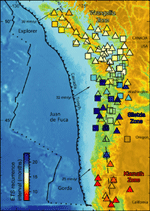| Home |
| Research |
| Downloads |
| Publications |
| Teaching |
| People |
| Press |
| Allen CV |
| Seismo Lab |
| Earth & Planetary |
| UC Berkeley |
Segmentation in Episodic Tremor and Slip All Along Cascadia
Mike Brudzinski
Miami University
Richard M. Allen
University of California, Berkeley
 Geology 35 (10) 907-910, 2007, doi: 10.1130/G23740A.1
Geology 35 (10) 907-910, 2007, doi: 10.1130/G23740A.1
Download a reprint:
BrudzinskiAllenGeology2007.pdf
(1.2 Mb)
Data repository:
BrudzinskiAllenGeology2007DataRepository.pdf
(0.9 Mb)
- From 2000 to 2006 there where 22 months during which an ETS event occurred, i.e. an average of one every 3.3 months.
- One-page summary of the presentation of this work to the National Earthquake Prediction Evaluation Council (NEPEC), May 2007:
AllenETS1page.pdf
- Animations showing the time history of ETS in Cascadia: 2000-2006 black and white (6.3 Mb); 1997-2006 color (10.0 Mb).
Abstract
The recent discovery of Episodic Tremor and Slip (ETS) in subduction zones is based on slow slip episodes visible in GPS observations correlated with non-volcanic tremor signals on seismometers. ETS occurs just inboard from the region capable of great megathrust earthquakes, however, whether there is any communication between these two processes remains unknown. In this study we use new single-station methods to compile an ETS catalog for the entire Cascadia subduction zone and compare the patterns with a variety of along-strike trends for the subducting and overriding plates. Correlated ground vibrations and strain observations are found all along the subduction zone, demonstrating ETS is an inherent part of the subduction process. There are 3 broad (300-500 km), coherent zones with different recurrence intervals (14+/-2, 19+/-4, 10+/-2 months), where the interval duration is inversely proportional to upper plate topography and the spatial extent correlates with geologic terranes. These zones are further divided into segments of ETS that occur at times typically offset from each other. The 7 largest (100-200 km) segments appear to be located immediately landward from fore-arc basins interpreted as manifestations of megathrust asperities, implying there is a spatial link between ETS and earthquake behavior. It is not yet clear if any temporal link exists, but the regional "hold time" between ETS episodes could be controlled by strength variations due to composition of geologic terranes.
© Richard M Allen
